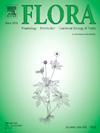Does seed morphology affect seedling emergence in Amazonian forest species?
IF 1.8
4区 生物学
Q3 ECOLOGY
引用次数: 0
Abstract
Morphological and morphometric knowledge, as well as assessments of fruit and seed quality and vigor, are crucial for the large-scale production of seedlings of Amazonian species. This study aimed to describe the morphometric characteristics of seeds from six forest species collected in the Volta Grande do Xingu region and to evaluate the effects of fruit morphology (fleshy vs. dry) and pre-hydration on seedling emergence. It also examined the relationship with the Emergence Speed Index (ESI), Mean Emergence Time (MET), and Emergence Percentage (EP). Fleshy fruits were defined as those with nutritional reserves in the mesocarp (Psidium densicomum Mart. ex DC., Virola surinamensis Warb., Genipa americana L.), while dry fruits lack a succulent pericarp (Hevea brasiliensis Willd. ex A. Juss., Carapa guianensis Aubl., Campsiandra laurifolia Benth.). A completely randomized design was adopted, with four replicates of 20 seeds each. The treatments applied were (1) hydration and (2) control (no hydration). Fruit morphology did not influence seed emergence indices. However, hydration for 24 hours resulted in a shorter MET and a higher ESI.
种子形态是否影响亚马逊森林物种的幼苗出苗?
形态学和形态计量学知识,以及果实和种子质量和活力的评估,对于亚马逊物种幼苗的大规模生产至关重要。本研究旨在描述在新古大伏尔泰地区采集的6种森林树种种子的形态特征,并评价果实形态(肉质与干质)和预水化对幼苗出苗的影响。研究了应急速度指数(ESI)、平均应急时间(MET)和应急百分比(EP)与应急速度指数(ESI)的关系。肉质果实是指在中果皮中具有营养储备的果实。交货。苏里南弧菌;而干果缺乏多汁的果皮(巴西橡胶树)。解析:选a。中华白桦;)。试验采用完全随机设计,4个重复,每个重复20粒种子。采用(1)水合处理和(2)对照(不水合)处理。果实形态对种子出苗指标没有影响。然而,24小时的水合作用导致MET较短,ESI较高。
本文章由计算机程序翻译,如有差异,请以英文原文为准。
求助全文
约1分钟内获得全文
求助全文
来源期刊

Flora
生物-植物科学
CiteScore
3.30
自引率
10.50%
发文量
130
审稿时长
54 days
期刊介绍:
FLORA publishes original contributions and review articles on plant structure (morphology and anatomy), plant distribution (incl. phylogeography) and plant functional ecology (ecophysiology, population ecology and population genetics, organismic interactions, community ecology, ecosystem ecology). Manuscripts (both original and review articles) on a single topic can be compiled in Special Issues, for which suggestions are welcome.
FLORA, the scientific botanical journal with the longest uninterrupted publication sequence (since 1818), considers manuscripts in the above areas which appeal a broad scientific and international readership. Manuscripts focused on floristics and vegetation science will only be considered if they exceed the pure descriptive approach and have relevance for interpreting plant morphology, distribution or ecology. Manuscripts whose content is restricted to purely systematic and nomenclature matters, to geobotanical aspects of only local interest, to pure applications in agri-, horti- or silviculture and pharmacology, and experimental studies dealing exclusively with investigations at the cellular and subcellular level will not be accepted. Manuscripts dealing with comparative and evolutionary aspects of morphology, anatomy and development are welcome.
 求助内容:
求助内容: 应助结果提醒方式:
应助结果提醒方式:


